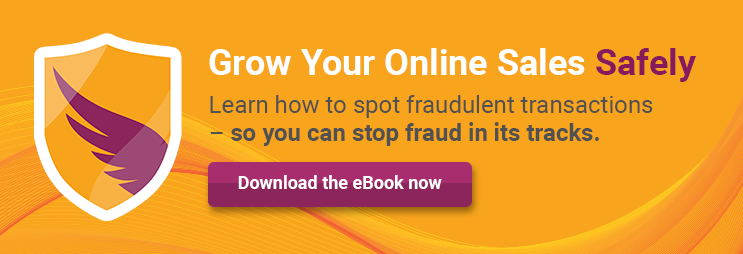How a Multilayered Fraud Management System Builds Customer Trust
Fraud as a percentage of revenue is on the rise — reaching 1.47% in 2016 (versus 1.32% in 2015). As the industry scrambles to put a stop to this horrible trend, one question looms large for small business owners:
How can I grow my business and manage fraud risk while strengthening customer trust and loyalty?
Implementing a comprehensive, multilayered fraud management system may be the answer.
The challenge, of course, lies in building a system that protects your business without getting in the way of sales. Let’s look some possible solutions.
5 Initial Steps to Protect Your Business from Online Fraud
E-commerce merchants have been bearing the brunt of this growth in fraud via increased card-not-present (CNP) fraud losses, which are estimated to exceed $7 billion by 2020.
It’s a tough problem that banks and card issuers have struggled to address. As a result, many business owners lack confidence in current fraud protection systems. Forced to take action themselves, some have tried to implement manual reviews to spot fraud, which is labor-intensive and sometimes complex to manage.
It’s not all bad news, however. By adopting a smarter strategy, you can protect your sales, your profits and your customers from credit card fraud. Here are the first steps you should take.
- Create a fraud prevention plan. Rather than shooting from the hip and hoping for the best, smart business owners put a solid plan in place that spells out how to handle day-to-day transactions as well as special concerns that might arise, such as language differences, foreign currencies, and seasonal sales spikes. This helps ensure that every order gets processed smoothly and quickly.
- Require card verification codes. These three- or four-digit codes help authenticate CNP transactions. Because these numbers are printed (not stored in the magnetic strip or embossed), fraudsters generally need the stolen card in hand to have this information.
- Verify orders before processing and shipping them. If you’ve received an unusual order — say, for an uncommonly high dollar amount — email the customer immediately and explain that the shipment will process and ship as soon as the payment is approved. Fraudsters may abandon the transaction; legitimate customers will understand the delay and appreciate your thoroughness.
- Use tracking numbers and require signatures upon delivery. Particularly for larger-ticket items, this can protect you against customers who claim their order never arrived (strengthening your defense against chargebacks) and create a paper trail for fraudulent transactions that may slip past the initial authentication.
- Require phone numbers for orders with different ship-to/bill-to addresses. A common trick in credit card fraud is to use the customer’s actual billing address but have the goods shipped to the thief at a different address. Consider requiring phone numbers for both addresses if the ship-to and bill-to addresses differ.
Creating a More Comprehensive Fraud Management System
Maybe you’re not confident that your fraud protection service can correctly distinguish between legitimate and fraudulent customers. Your goal: Catch the fraudsters without alienating legitimate customers. If you make the wrong call, you risk losing the good ones, as well as the lifetime value of their future purchases.
Could it be that you’re not layering your solutions properly — or that you’re using the wrong combination of solutions?
Entirely possible.
Studies suggest that integrating multiple layers — such as cross-checking billing addresses with the IP address of the computer used to place the order — is -the key to reducing the number of successful fraudulent transactions and decrease the costs of fraudulent losses.
Such an approach also helps you identify transactional patterns. Single red flags shouldn’t be enough to cause you to reject a transaction automatically; doing so is a surefire way to block legitimate sales. Instead, consider the transaction from multiple perspectives when reviewing them for potential fraud.
It’s important to understand that there is no ONE perfect solution. Instead, merchants must educate themselves about the value each individual solution offers and then invest strategically in a multilayered fraud mitigation approach.
How a Multilayered Approach Builds Customer Trust
Besides reducing fraudulent transactions and their associated costs, a multilayered approach also benefits customers.
No customer wants to be contacted about a potential fraudulent issue. But if the potential fraud is handled in a timely, personalized way (with contact from either dedicated staff or a virtual fraud analyst), it can actually increase customer trust.
As customers feel that your business is genuinely interested in their well-being, they begin to feel more confident about your business and the value you deliver. In return, they’ll be more likely to reward you with their loyalty. And loyalty is what drives future spending, which increases your revenue and profit.
Simple contact. Simple solution. Big payoff.
Combat Fraud, Grow Sales and Build Trust
Combating retail fraud isn’t just about the quantity of solutions you employ. It’s about selecting the right solutions for your business and then layering them for additional security.
By attacking fraud from different threat perspectives, such as a customer’s identity, information and transaction risk, layering solutions can help reduce false positives and the number of successful fraud attempts – all while building customer trust and growing your online sales.
Fraud is serious business, and your business has a lot at stake. Take time to research, establish and implement a comprehensive plan for battling fraud that will protect both you and your customers.
Interested in learning more about how to grow your e-commerce sales safely? Download our “Online Credit Card Fraud Risk” ebook today, or contact one of our fraud protection analysts at contact@clear.sale.
 Sarah Elizabeth
Sarah Elizabeth
